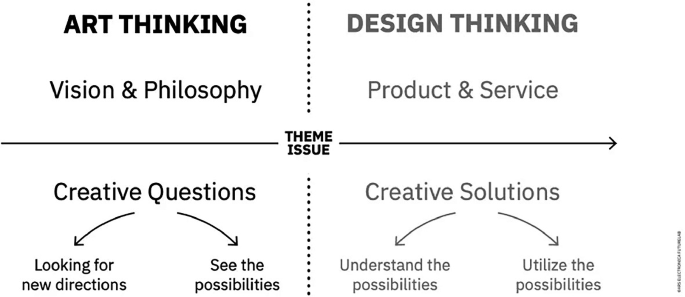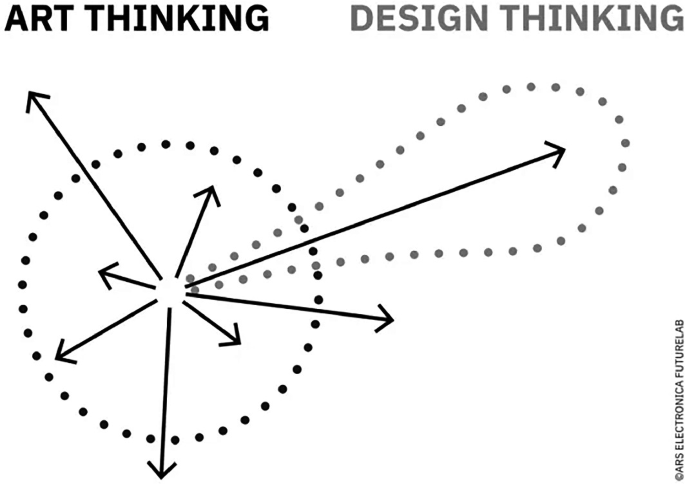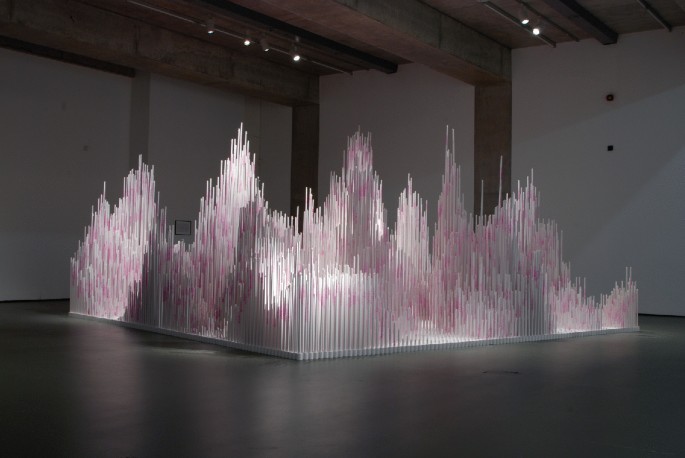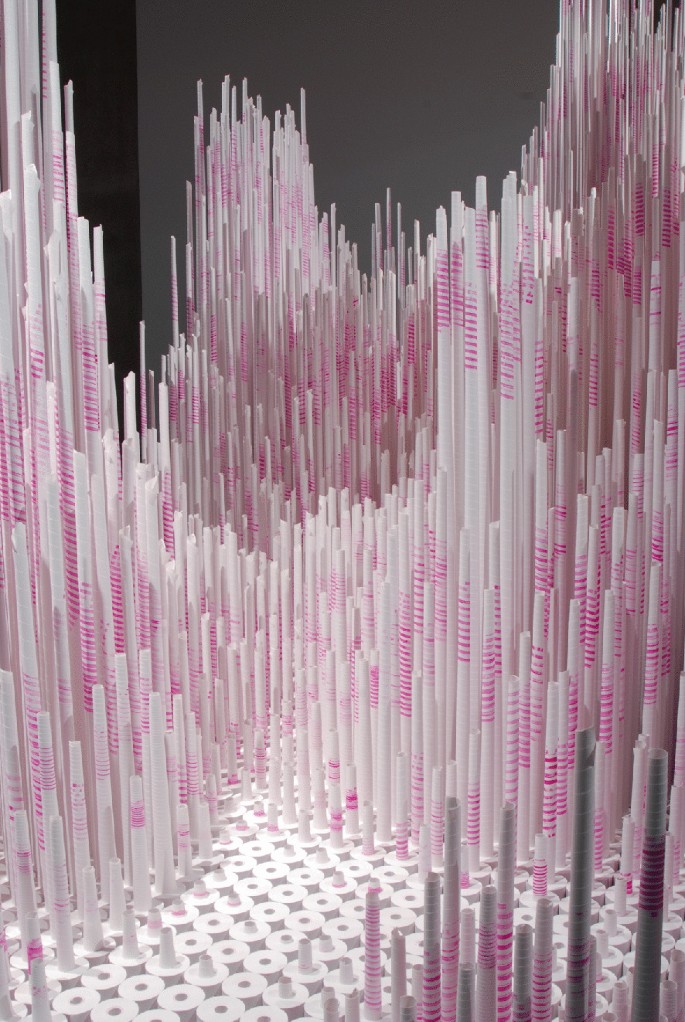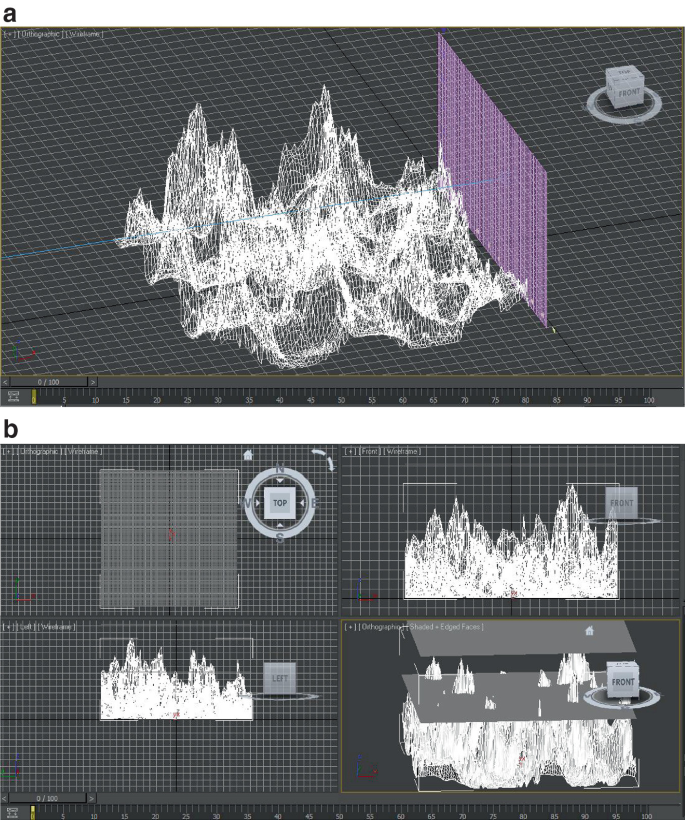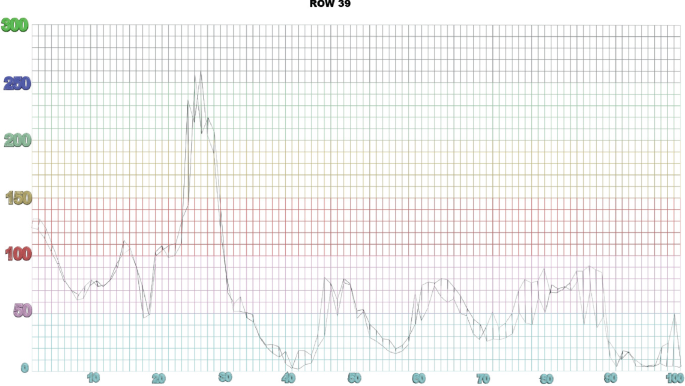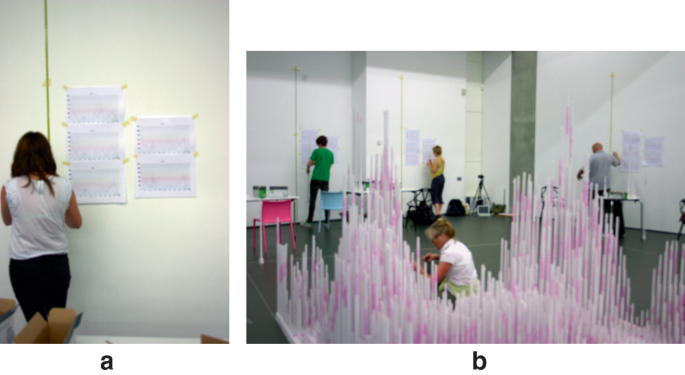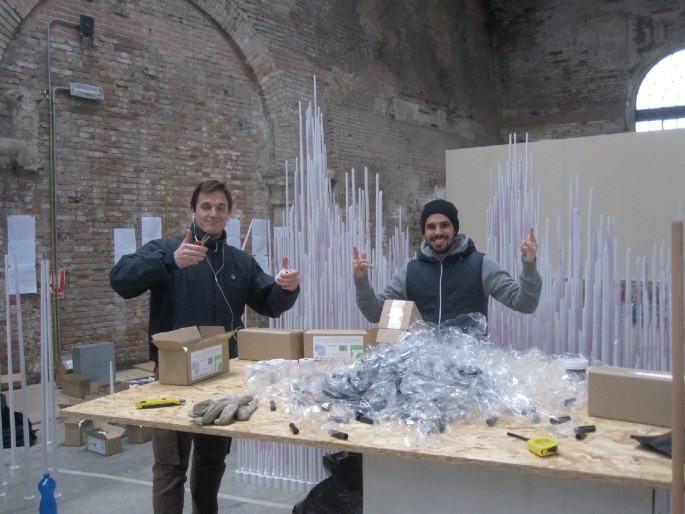Abstract
A broader spectrum of creative practice is considered more closely, distinguishing between art and design as different entities within the creative tradition. Drawing distinctions between these two forms, could help us understand creativity with more breadth. Creativity may be classified across two domains in the visual arts, art thinking and design thinking. This distinction has a long tradition, however, research outside of practice-based analysis has introduced it as a multidisciplinary tool. Art thinking has in this way expanded beyond art practice and is applied as a general method for observing and utilizing patterns, in all types of creative activities.
You have full access to this open access chapter, Download chapter PDF
Similar content being viewed by others
Keywords
8.1 Introduction
A simple example or case study, ‘Till Rolls’ (Townsley), offers a situation where analog problems, revealed through art thinking (the process of making) are solved using design thinking and digital technology.
Artist and researcher, Hideaki Ogawa investigates art thinking in his work at FutureLab, a research stream at Ars Electronica; the Austrian cultural, educational, and scientific institute. He asks: what is the role of art in the twenty-first century? and how may it be applied for the benefit of our future societies? To help answer this he makes a binary distinction between creativity in art and design:
Art creates creative questions and design creates the creative solutions [1].
Ogawa’s proposition re-defines a long-acknowledged contrast between art and design; by addressing creativity as a form of thinking, leading to two distinctly different outcomes. Analyzing the differences and similarities between these two disciplines could identify important breadth across the single term creativity. Such distinctions may also indicate how collaboration may contribute toward more diverse and complete creative outcomes. This knowledge is then applied to consider how creativity may develop across the digital and analog world.
8.2 Design Thinking
Ogawa outlines the considerable strength of design thinking to influence the world we live in, by providing solutions to problems, resulting in products and services that help navigate existence (Fig. 8.1).
Design Thinking is effective for creating and shaping creative solutions for the future [1].
https://ars.electronica.art/futurelab/en/research-art-thinking/, reproduced with permissions
The closeness of design thinking to productivity is clear, design evolves the creative solutions, understanding and utilizing possibilities in order to produce products and services.
Design thinking as a creative method became a ubiquitous term in the 1990s, to describe the practical, cognitive, and strategic processes involved in developing design proposals. These processes include, context analysis and framing, ideation and solution generating, creative thinking, sketching and drawing, modeling, and prototyping and testing. They also involve evaluating ill-defined problems with solution focused strategies, and as such has often been an oversimplified route proxy for creative thinking [2].
However, Design Thinking is defined differently by different authors.
Brown (2008) defines it as “a discipline that uses the designer’s sensibility and methods to match people’s needs with what is technologically feasible and what a viable business strategy can convert into customer value and market opportunity [3]
and Leidtka and Ogilvie [4] frame design as “a systematic approach to problem solving. It starts with customers and the ability to create a better future for them”. The concept of artistic interventions has an inclusive definition by Berthoin Antal
bringing in people, practices, and products from the arts to help address issues their organizations are facing [5].
Design thinking has been criticized by Bruce Nussbaum [6] among others for its textbook methodology that promises quick fixes for organizations at the expense of genuine creativity. Critics argue that design thinking has stripped out the messiness of the creative process when conflict, failure, emotions, and constant repetition is at the very heart of the creative process. Through focusing only on what the user wants, there is a significant risk that we may not be asking the right questions.
8.3 Art Thinking
Art Thinking on the other hand, is a much more dispersed activity, adept at raising creative questions, at looking at problems from different angles to define a landscape and propose new strategies and approaches toward the future.
Well established forms of critical thinking are key to discovering creativity in art thinking. Creativity developed with critical understanding, supports creative artwork that has contextual resonance. The aim is not to offer definitive conclusions or answers but to raise questions and to bring into some focus the ever-changing cultural landscape. This complexity is defined by Ogawa
Art is a catalyst for shaping a better future society, a way to open up new perspectives, encourage curiosity to look at what is behind the scenes and to stimulate creative solutions. Art Thinking is a process of applying artistic thinking and an artful view to a broader range of challenges [7].
With this statement Ogawa acknowledges that the creativity embedded within the art object can be very different to a design object (Fig. 8.2). Creativity engaged in art thinking often deals with conjecture, presenting multiple viewpoints, sometimes simultaneously, posing fuzzy questions and offering incomplete possibilities.
https://ars.electronica.art/futurelab/en/research-art-thinking/, reproduced with permissions
This creativity produces cultural collateral whose aim is not determinative or ‘smart’, often placed not to solve specific questions, but grow them. This is a risky place for an economic system that predominantly searches for solutions, where success is to cultivate the investment in wealthy returns. For the artist, this form of creativity usually engages contextual referencing, indicating the conceptual landscape the artwork intends to engage with. Successful communication of this open form is completed by the viewer, with the professional critic playing a significant role, placing art thinking within a socially contextual and cultural milieu.
The creative reach of art thinking (the ability of the art object to engage large numbers of people) is difficult to predict, as its success depends on its contextual position within society, including the space and time of its encounter. Through art thinking, creativity can be activated in a way that can be shared within society, from origin to reception, referenced through culture, and relational to the social engagement of people. Relational engagement can draw people together socially across time and space, even traveling across cultural differences. Creativity here is operating in a most powerful and often unpredictable manner, it is often referred to as ‘soft power’ [8], having the ability to co-opt rather than coerce.
8.4 Case Study ‘Till Rolls’—Art Thinking Collaborating with Design Thinking
In 2008, the Towner Contemporary art gallery in Eastbourne, commissioned a large-scale installation for an exhibition named ‘Compulsive, Obsessive, Repetitive’ (2011). At the beginning, the installation was proposed as a creative concept, its existence was potential, on paper only, and it was proposed three years ahead of the gallery’s opening, even before the gallery building was constructed.
Till Rolls (Fig. 8.3) is a temporary sculptural installation, conceived to stand on a gridded footprint 5.7 m square, and reaching a height of 3 m at its highest point. It was made only from tightly packed rolls of paper, 10,000 of them. The paper rolls are manufactured for use in shop tills (cash machines) to store accounts and print receipts. It is a simple mechanism to record countless human interactions around trade, cataloging the exchange of goods for money. Each till roll occupied its own space on the floor in a grid system, 100 rows long and 100 rows wide (Fig. 8.4). To form the sculpture, the center of each till roll was extruded, lifted into the space above the grid. At different heights each till roll contributed to a rolling landscape, a three-dimensional graph configuring the hills and valleys of the space above the grid.
To construct Till Rolls in the gallery space presented specific contingent problems. The installation time was to be only 4 days, allowing no opportunity for reflexive thinking within the creative process. These are important decisions on shape and form, art thinking traditionally solved in the privacy of the studio, through trial and error, and within the execution of the work. In this case, creative judgments must be addressed prior to the making process, while still at the proposal stage. A strategy was needed to ensure that the work would fulfill a specific pre-conceived structure and could be built in the short timeframe. Such problems often require collaboration across other disciplines such as engineering, science, or technology, requiring the skills of design thinking.
8.5 Design Thinking in Till Rolls
The next phase of Till Rolls offers a good example of simple collaborative creativity located within design thinking, employed to solve specific problems arising from art thinking. The design questions were:
-
1.
How to build the work in only four days, considering the time it takes to manually extrude each of the 10,000 till rolls?
-
2.
How to identify the height of each till roll and where to place it correctly within the sculpture’s gridded footprint, so that the correct pre-conceived shape of the whole installation could be realized?
-
3.
How to empower a team of gallery assistants to work independently to construct the sculpture.
To help solve these problems a collaboration was formed with digital design specialist and Principal Lecturer, Dr. Ertu Unver (University of Huddersfield).
Dr. Unver was able to see that digital 3D polygon modeling tools could offer useful creative solutions [9]. The digital space has the advantage of providing a virtual place for creative comparison across potential outcomes. It enabled the artist to make critical and creative decisions toward realizing the final shape of the installation. These are fundamental decisions integral to sculptural practice. Using digital technology in this way formed a bridge between design thinking; to solve the concrete problem, and art thinking; enabling appropriate creative possibilities for the future sculptural form.
Once decisions about the final shape of the work were made, the polygon modeling program was able to capture the digital information in a way that could be reconfigured (Fig. 8.5a). The whole digital sculpture was then cut into 100 slices which allowed the height and position of each of the 10,000 till rolls to be plotted onto two-dimensional graphs. Each graph, once printed, could be used as a map for construction in the gallery. The graph offered the location of each till roll along the bottom axis, while the vertical axis plotted its height in centimeters. This resulted in 100 graphs collectively articulating a floorplan for the whole work and helping to systemize the process of construction (Fig. 8.5b).
The graphs enabled a changing group of artists assistance, gallery volunteers and community groups, to work independently across each row, with the confidence that each till roll was extruded to the right height to form the sculpture, and then placed in the correct spot on the floor of the gallery (Fig. 8.6).
An important outcome from collaboration, across design and art thinking, was that this temporary artwork was organized with a procedural method that could be accurately repeated. Offering opportunities for the work to be rebuilt in different galleries and contexts (Venice Arsenale, Washington DC, Huddersfield Art Gallery).
The virtual object realized through a collaboration of art and design thinking, offered space for critical analysis pertinent to both art and design procedures. It also provided the systematic procedure for the construction of the work with artist, designer, digital specialist, gallery assistance, and public volunteers, all having an individual role within the authorship of the sculptural installation (Figs. 8.7a, b, and 8.8).
8.6 Design Thinking and Art Thinking in the Technological Space
While the difference between art thinking and design thinking as defined by Ogawa is clear, there is also a coming together of art and design especially evident in digital technology. There are many creative examples of contemporary artists expanding their studios to include designers and artists working together. Technology companies have also expanded to broaden their skills to include both artists and designers with an understanding that each offer different forms of creativity.
Art thinking created the first iPhone; design thinking made it a manufacturable, cultural phenomenon [3].
In Ogawa’s model the value of creativity in design is its preoccupation with problem solving, in contrast to creative artistic interventions that are concerned with problem finding. This makes the discourses of creativity within technology subtly different too, with the separation between them not clearly defined in the single term. John Lasseter, formerly chief creative officer at Pixar, and now head of animation at Skydance Animation, describes the equation this way: “Technology inspires art, and art challenges the technology” [10].
To understand how to improve new products, feedback and critique is necessary, and this is where artistic thinking can help, as Jobs points out this happens very often across traditional disciplines.
It’s in Apple’s DNA that technology alone is not enough—it’s technology married with liberal arts, married with the humanities, that yields us the results that make our heart sing [11].
Art and design students practice critique often defined by the humanities or socially through worldly experience that enables them to develop their creative work. This connects them to a cultural context, a relational world that is always changing, always infinitely complex.
8.7 Conclusions
One way to address how creativity may operate across the analog and digital divide in the future, is to look at the way visual arts and artists engage different forms of creativity across different visual art disciplines today. The aim is to consider how creative process can generate social justice and produce cultural value [12].
Defining creativity as distinctly different in its action when applied across design or art practice is a useful tool to analyze. It is also relevant to understand how creativity supports critical thinking, and even how it can drive cultural change.
Ogawa provides us with a deeper understanding of the forms of creativity that may be appropriated, through collaborative means, to realize and construct contemporary artwork. While creativity is known to be integral to all artistic endeavor, artists are also increasingly collaborating with other disciplines to broaden the forms of creativity available to them. This enables artists to develop artwork fit for our highly interfaced and conceptually broad contemporary contexts. Often this produces artwork that can interact with technological development to help define our societal selves. Creativity can investigate our relationship to external and conceptual systems, such as time, temporality and how we experience creative communication from source to interpretation through reception.
The next chapter deals with contextual referencing and its fluidity within socially agreed cultural systems.
References
Ogawa, H.: Art Thinking. Ars Electronica Futures Lab. Electronic resource: https://ars.electronica.art/futurelab/en/research-art-thinking/
Cross, N., Dorst, K., Roozenburg, N. (eds.): Research in Design Thinking. Delft University Press (1992)
Brown, T.: Design Thinking. Magazine article. Harvard Business Review (2008)
Leidtka, J. Ogilvie, T.: Designing for Growth: A Design Thinking Tool Kit for Managers. Columbia University Press (2011), p. 4
Berthoin, A., Straub, A.: Artistic Interventions in Organisations: Finding Evidence of Values-added. Creative Clash Report. WZB, Berlin (2013)
Nussbaum, B.: Creative Intelligence: Harnessing the Power to Create, Connect, and Inspire. HarperBus (2013)
Ozawa, H.: Art Thinking. Ars Electronica Futures Lab. Electronic resource: https://ars.electronica.art/futurelab/en/research-art-thinking/
Joseph, S.: Soft Power: The Means to Success in World Politics. Public Affairs, New York (2004)
Unver, E., Townsley, J.: Integration of 3D Technologies to Communicate Large Scale Sculpture Installation: Till Rolls Case Study. University of Huddersfield (2011). https://pure.hud.ac.uk/en/publications/integration-of-3d-technologies-to-communicate-large-scale-sculptu
Lasseter, J.: In: O’Keefe, A., Dweck, C., Walton, G. (eds.) Having a Growth Mindset Makes It Easier to Develop New Interests. Harvard Business Review (September 2018). https://hbr.org/2018/09/having-a-growth-mindset-makes-it-easier-to-develop-new-interests
Jobs, S.: Apple Launches iPad 2. San Francisco Live Event Apple Newsroom (2011)
Mould, O.: Against Creativity. Verso Books, London (2020)
Author information
Authors and Affiliations
Corresponding author
Rights and permissions
Open Access This chapter is licensed under the terms of the Creative Commons Attribution 4.0 International License (http://creativecommons.org/licenses/by/4.0/), which permits use, sharing, adaptation, distribution and reproduction in any medium or format, as long as you give appropriate credit to the original author(s) and the source, provide a link to the Creative Commons license and indicate if changes were made.
The images or other third party material in this chapter are included in the chapter's Creative Commons license, unless indicated otherwise in a credit line to the material. If material is not included in the chapter's Creative Commons license and your intended use is not permitted by statutory regulation or exceeds the permitted use, you will need to obtain permission directly from the copyright holder.
Copyright information
© 2023 The Author(s)
About this chapter
Cite this chapter
Townsley, J. (2023). Art Thinking and Design Thinking. In: Creativity in Art, Design and Technology. Springer Series on Cultural Computing(). Springer, Cham. https://doi.org/10.1007/978-3-031-24869-6_8
Download citation
DOI: https://doi.org/10.1007/978-3-031-24869-6_8
Published:
Publisher Name: Springer, Cham
Print ISBN: 978-3-031-24868-9
Online ISBN: 978-3-031-24869-6
eBook Packages: Computer ScienceComputer Science (R0)





